Everest through the eyes of a Sherpa: 'Climbers need to wake up’
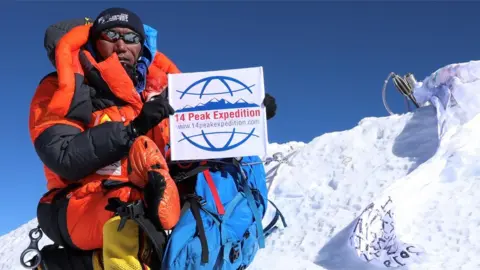 AFP / Seven Summit Treks
AFP / Seven Summit TreksAt least 11 people have died trying to climb Mount Everest this year. Kami Rita Sherpa, who's been to the world's highest summit more times than anyone else, tells the BBC too many climbers are led to believe Everest is easy.
On 13 May, exhausted and struggling to breathe, a Chinese climber in her early 30s staggered into Camp 3. At 7,162m (23,500ft) it was higher than she had ever climbed before. But the expedition was not going to plan and her dream of scaling Everest was slipping away.
Helping the woman, who did not want to be named, with her oxygen mask was the group's leader, Kami Rita Sherpa. Not just any mountain guide, but the world-record holder for summiting Everest - he notched up his 24th ascent to the summit later that month.
"I always try to make sure every client succeeds to the summit," says Kami. "But there is a line. The moment I realise that any of my clients will not make it, I will abort the mission."
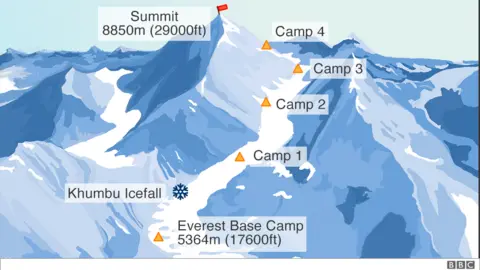
Even from the outset, Kami saw that his client was struggling. Days earlier, she took 19 hours, twice the expected time, to trek from Base Camp to Camp 2. When she finally arrived, Kami made the decision she simply wasn't ready for the summit and had her flown back down to Kathmandu by helicopter.
Rejoining the group a few days later, setting off from Base Camp, things started well. But by 6,000m, she was already heavily reliant on supplementary oxygen, a resource normally reserved for altitudes of 7,000m and above. By the time they arrived at Camp 3, Kami had made up his mind. The risk was too great - he ordered her to be taken back down the mountain to safety.
"There is always a risk of avalanche and above Camp 3 the path is steep and treacherous," says Kami. If in doubt, descent is always the best decision, because Everest will always be there if you survive."
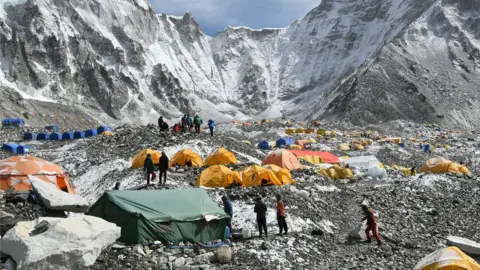 Getty Images
Getty ImagesEverest is always dangerous. But this season, the death toll has been the highest for four years.
Overcrowding, bad weather and a record number of permits being issued may all be contributing factors. But Kami believes it's an increase in the number of less experienced climbers, like his client, that are making the problem worse. He blames some tour companies for underestimating the risks to novice climbers.
"Overcrowding is nothing new. This is not the reason people are dying. It's pressure on young climbers by some companies describing Everest as easy. Everest is never easy."
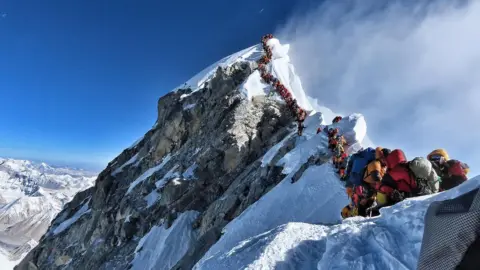 AFP PHOTO / PROJECT POSSIBLE
AFP PHOTO / PROJECT POSSIBLEMany veteran climbers, such as expert mountaineer and writer Alan Arnette, have also warned of the risks of tourists with little or no training attempting to scale huge peaks such as Everest.
"Climbers need to wake up and understand that climbing a big peak like Everest is extremely risky. They need to stop believing just because they are with a 'Sherpa guide' who has summited Everest 10 times that they will be rescued if they get in trouble," says Alan.
"Even the strongest Sherpa cannot take an incapacitated person lower by themselves or expect extra oxygen to be delivered to 8,400m at a moment's notice. And helicopters have their limits, as do rescue policies and GPS devices."
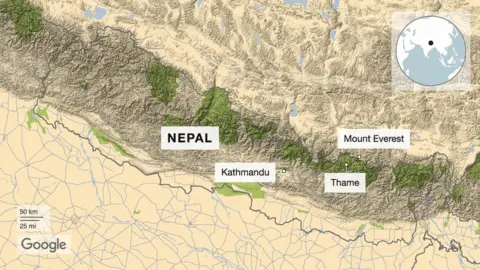
Towering 8,850m above sea level, Mount Everest is the most famous mountain in the world. Located on the Nepal-Tibet border, this global beacon of exploration and endeavour lures hundreds of climbers every year.
But as Kami says: "Without a Sherpa, there is no expedition."
Descended from Tibetan heritage, the Sherpa community are an ethnic group, indigenous to the Himalayan region. But for many outside Nepal, the word "Sherpa" has become synonymous with those working as mountain guides.
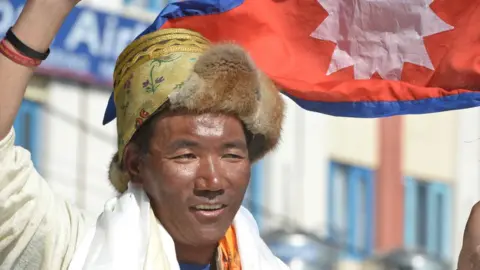
Mostly young men, Sherpa guides are not just the muscle behind any expedition - carrying extra gear such as oxygen bottles, water and food - they are also expert navigators. Enduring freezing temperatures of -30C down to -50C, they help climbers to negotiate icefalls, avalanches and extreme altitude.
From Camp 4 up to the summit, climbers will enter what is commonly known as the "death zone". Operating above 8,000m, 95% of climbers will rely on supplementary oxygen carried in bottles. Sherpas must ensure their clients conserve their oxygen supply for the return journey.
"I keep checking everyone's oxygen levels, and in the event of extreme weather, I make strategic decisions about whether we ascend or descend to avoid any developing situations in the mountains," explains Kami.
Working as a mountain guide since 1992, last month Kami broke his own world record not just once, but twice. On 15 May, he reached the summit with 15 clients from China, before returning on 21 May with a second group of 11 climbers from India.
"I treat every climb with the same sincerity as the first," says Kami. "Whenever a client is successful, it makes my day. I believe breaking records is just a by-product."
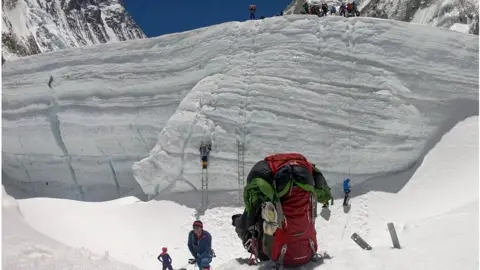 Getty Images
Getty ImagesAlthough the climbing season is short, often only a single week in mid-May, Sherpas look after the mountain for a total of three months. As well as fixing ropes and ladders before climbers arrive, they also undertake a huge clean-up operation, clearing the tonnes of rubbish left behind on the mountain.
In the language of Tibet, Mount Everest is known as Chomolungma, meaning goddess mother of the world. Many Sherpas believe that the summit of Chomolungma is home to the Buddhist goddess Miyolangsangma. It was she, they say, who allowed the first explorers, Sherpa Tenzing Norgay and New Zealander Edmund Hillary, to reach the top in 1953.
For the Sherpa community, the mountain is not just a mass of rock, but a deity to be revered and cared for.
"We worship and have deep respect for the mountain," says Mingma Tenzi Sherpa, who has reached the summit eight times. "We trust it will save us from whatever comes."
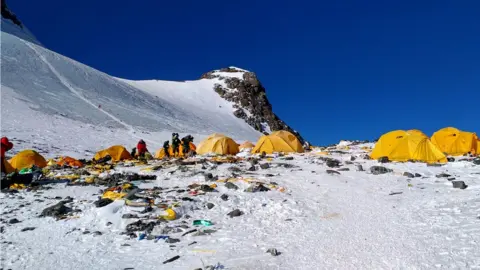 Getty Images
Getty ImagesKami grew up in the same mountain village as Tenzing Norgay. Thame is just 20km (13 miles) from Everest Base Camp, and the colossal Himalayan mountain range influenced many aspects of his childhood. Just getting to school meant a four-hour trek and put young Kami's climbing skills to the test.
Life was hard. The area is far from major towns, food was often scarce and healthcare almost non-existent.
To earn extra money, aged just 10, Kami dropped out of school and began trekking with his elders up peaks exceeding 3,000m. In the evenings he'd listen to their stories, tales of the mountain passed down through generations of Sherpas.
"I wanted to be a monk and spent five years training at a nearby monastery," says Kami, "but how could I look for inner peace when back home the lives of my parents hung in the balance? There was no option but to return to climbing."
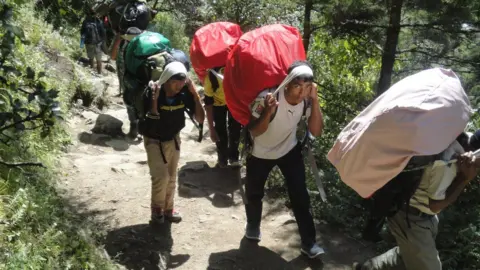
Still today, almost every household in Thame depends on the passing trade from visiting climbers; running lodges, transporting supplies back and forth on yaks and ponies, or working up at Everest Base Camp as a porter or cook.
However, it's the Sherpas who guide foreign climbers all the way to the summit who make the most money, bringing home between $5,000 (£3,960) to $8,000 (£6,330) in a single season.
In 1992, aged 22, Kami began working as a kitchen porter at Base Camp. Luckily for Kami, his older brother Lakpa was also working on the mountain as a guide taking climbers up to the summit.
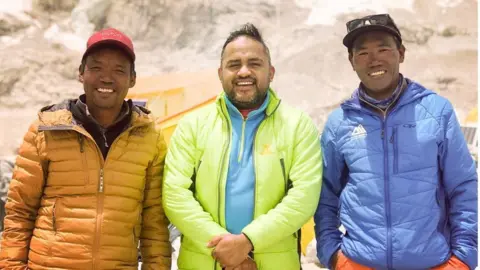 Kami Rita
Kami RitaFor the next two years, Lakpa took Kami under his wing, pushing him through rigorous high-altitude training and getting him work guiding small groups out on short trips to help them acclimatise. Then in 1994, Kami finally got his first shot at the top.
The night before the final push to the summit, Kami remembers being too anxious to sleep. Instead, he thought about what his fellow Sherpas had advised: "Just pray for good weather!"
The following day under clear skies, both Kami and his client made their first ascent to the top.
"In that moment, my happiness was not about my first summit, but that my life would now be easier. With the summit of Everest on my resume, I would get more work."
 Getty Images
Getty ImagesSince Kami Rita's first ascent in the mid-1990s, technologies such as weather prediction systems, helicopters, climbing gear and satellite communications have all revolutionised the adventure industry. But rather than alleviating the demands on them, Sherpas say they have only increased.
With growing numbers of aspiring climbers arriving year upon year, more mountain guides are needed than ever before. This year 381 climbing permits were issued on the Nepal side, the highest since records began in 1953.
Tour companies charge visitors anywhere between $30,000 and $130,000 or more, in return for organising their permits, equipment, finding a guide, and ensuring an emergency plan is in place. This also includes an $11,000 fee which goes directly to the Nepalese government.
High-end luxury packages may include up to as many as five Sherpas per climber to manage bespoke demands such as unlimited bottled oxygen, more comfortable tents or even hot showers.
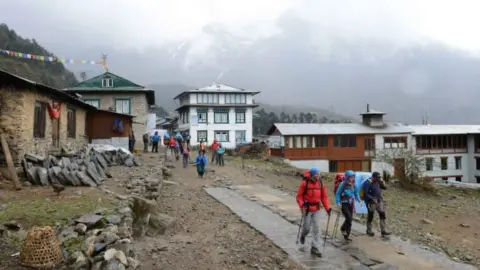 Getty Images
Getty ImagesKami describes his community as the "army of the mountains". But like many Sherpas, he feels that despite being an integral part of Nepal's tourism industry, their contribution is barely recognised by the government.
"We sacrifice everything for the mountain," says Kami. "We know the mountains the best and can help to save them like no-one else can. But the government has to trust us and make our profession a secure one."
According to Nepal's Department for Tourism, since 2010 the total number of registered Sherpas has decreased by a fifth. Many say they would prefer their children to stay in school rather than follow in their footsteps.
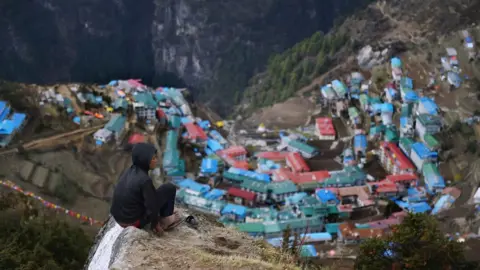 Getty Images
Getty ImagesMany of Kami's frustrations with his own government relate to his experience on 18 April 2014, when 16 Sherpas were killed after a devastating avalanche at Khumbu Icefalls.
The icefall is a notoriously steep and treacherous part of the Khumbu glacier which climbers must negotiate between Base Camp and Camp 1. It is considered by most Sherpas to be more dangerous than standing on the top of Everest because large pieces of ice can easily become dislodged without warning.
Following the tragedy, the Nepalese government introduced medical and life insurance policies for all Sherpas working on the mountain. But for Kami, who lost an uncle and two close friends in the disaster, this was simply not enough.
On the day of the avalanche, he remembers being woken by his brother rushing into his tent at Base Camp. Following Lapka out on to the ice, Kami saw large groups of Sherpas gathered around on walkie-talkies.
Less than 2km north, dozens of Sherpas had been preparing the path at the icefall for the next season of incoming tourists. Huge blocks of ice the size of cars broke off the nearby glacier and fell over 1km right on top of where the group of Sherpas were working.
"We've always feared the Khumbu Icefall," Kami says. "But that day, our fear materialised into a catastrophe."
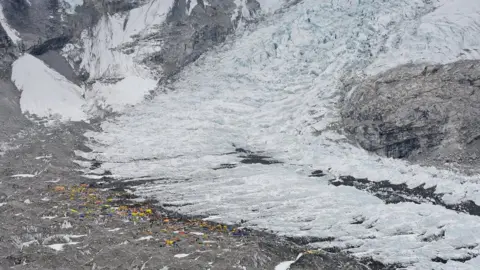 Kuntal Joisher
Kuntal Joisher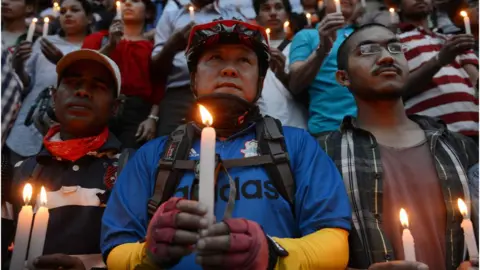 Getty Images
Getty ImagesAs the brothers headed up the mountain to help, Kami remembers seeing human limbs scattered in the snow. His brother discovered 11 bodies which had been forced together under the impact of the avalanche.
"We tried our best, but in the mountains, everything happens so quickly. We were powerless," says Kami.
As compensation, the government offered $400 to every family affected, less than a quarter of what a novice Sherpa would hope to bring home in a single season. The community were furious.
"That was all our lives were worth!" says Kami.
After the avalanche, Lakpa vowed never to return to the summit again. He now manages expeditions only from Base Camp. However, Kami, with little education, felt he had no alternative but to carry on climbing. His fear of the icefall has never left him.
"It's still the same," he says. "I still see the bodies sticking out of the ice every time I pass by."

After months of being away from his wife and children, on 25 May Kami finally arrived home. His wife Lakpa Jangmu had made a cake with the candles "24" confirming her husband's record-breaking achievements.
But surrounded by trophies stacked up along the living-room shelves and a life-sized poster of "Kami, the world record breaker" mounted just behind the sofa, it all raised the question, would he set out to break his own world record again next year?
"So many things in my life are uncertain and left without a plan," he says with a cheeky smile.
"I will think about next year... next year."
Production and graphics by Claire Press
